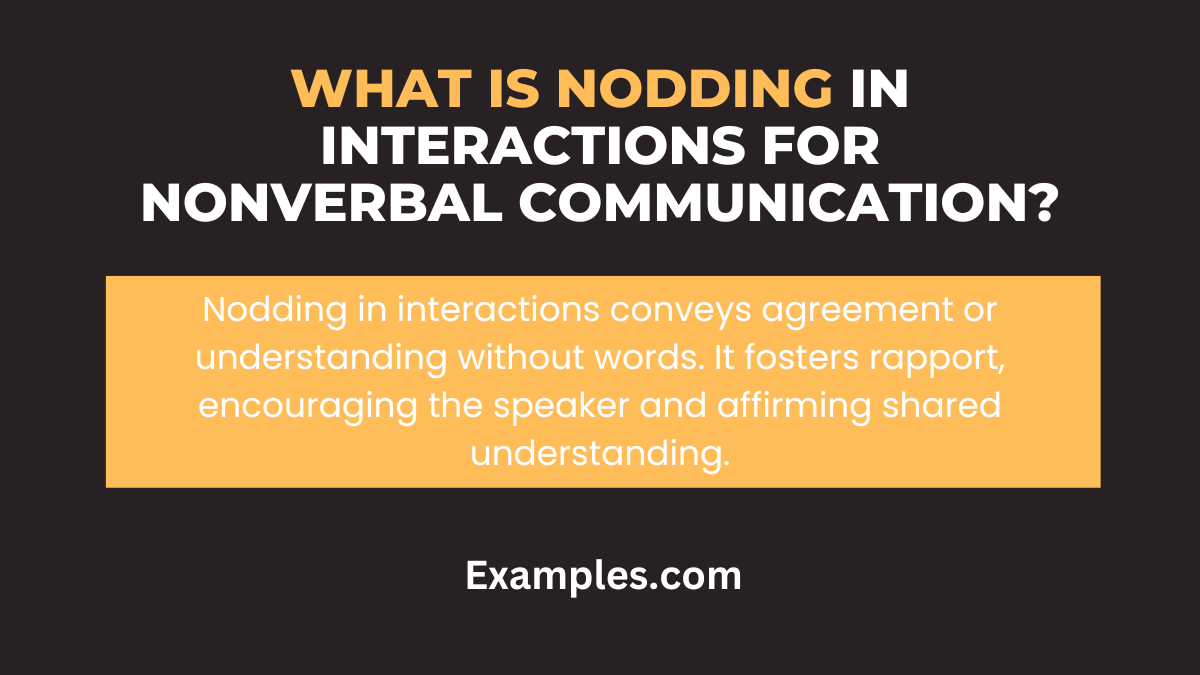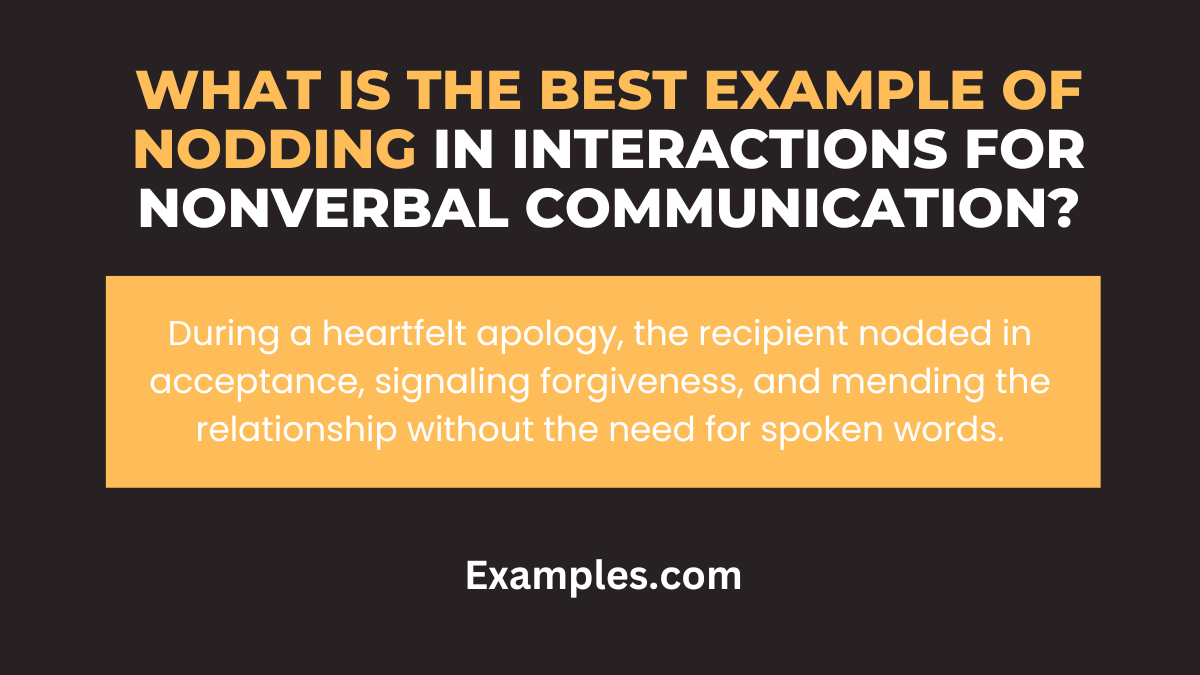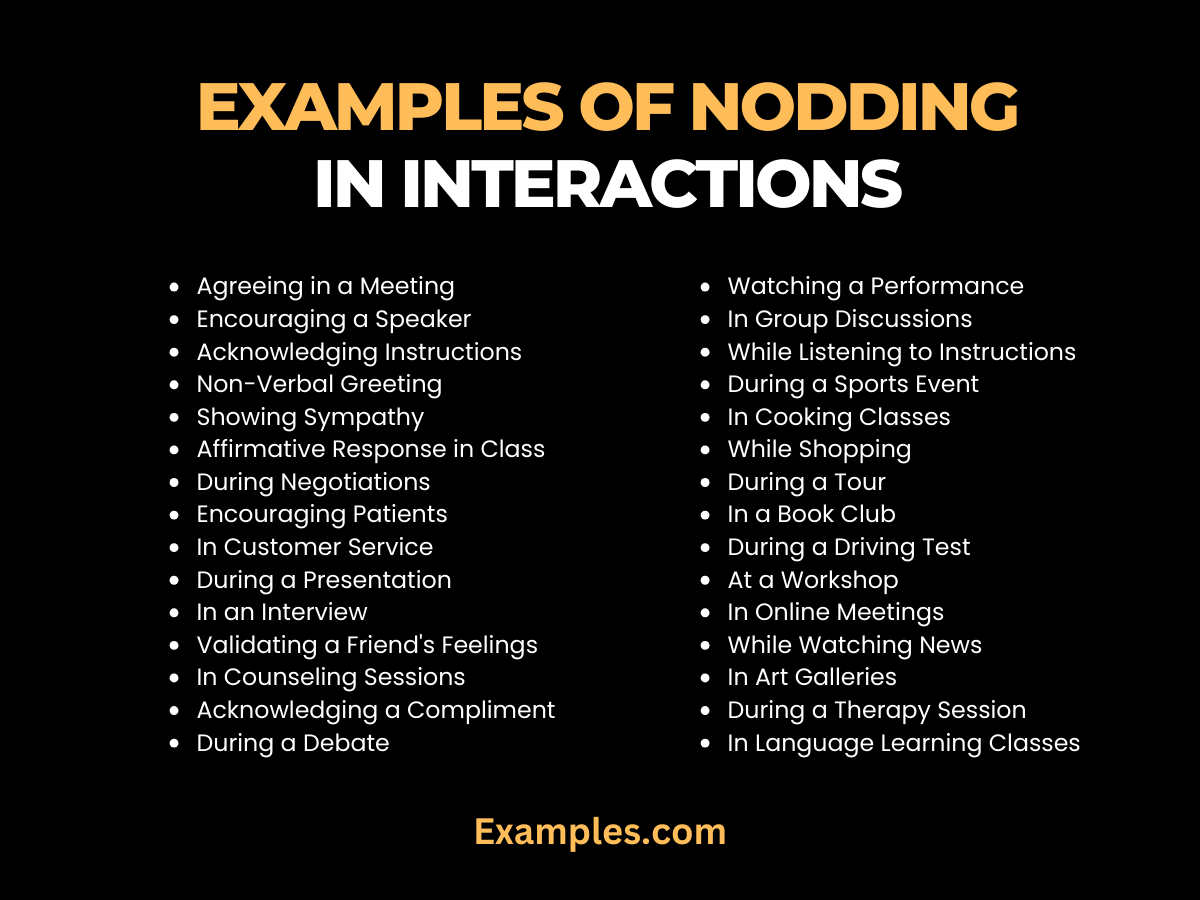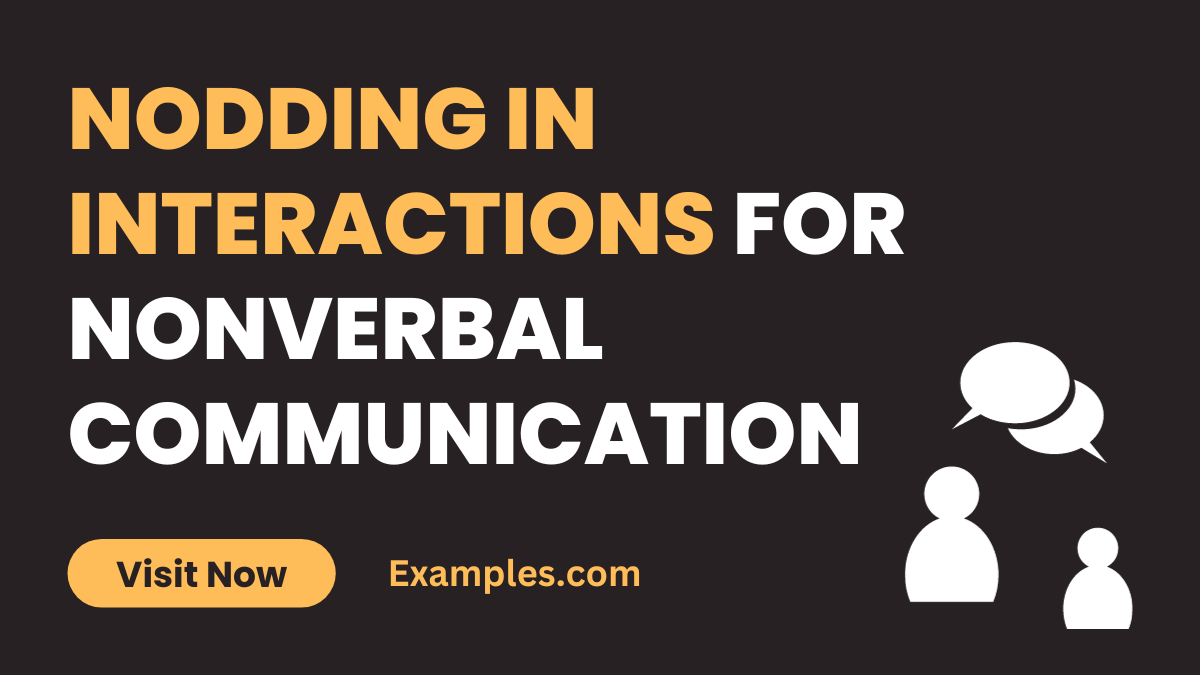29+ Nodding in Interactions for Nonverbal Communication Examples
Nodding in interactions is a vital part of nonverbal communication examples, providing subtle yet powerful cues in our daily interactions. This guide explores the nuanced world of nodding, from subtle affirmations to emphatic agreements. Nodding, a seemingly simple gesture, plays a crucial role in effective communication, enhancing understanding and rapport between individuals. By mastering the art of nodding, you can significantly improve your nonverbal communication skills, making every interaction more meaningful and impactful.
What is Nodding in Interactions for Nonverbal Communication?

Nodding in interactions for Nonverbal Communication refers to the act of moving one’s head up and down, typically in agreement or acknowledgment. This gesture is a form of body language that conveys a range of messages without the use of spoken words. Nodding is universally recognized as a sign of agreement, understanding, or approval. It’s a subtle yet powerful way of communicating in various social and professional settings.
What is the Best Example of Nodding in Interactions for Nonverbal Communication?

One of the best examples of nodding in Nonverbal Communication occurs during a conversation, where one party nods to show they are actively listening and understanding what is being said. This type of nodding enhances the flow of communication, indicating that the listener is engaged and encouraging the speaker to continue. In professional settings, such as meetings or presentations, nodding can also signify agreement or approval, often reinforcing verbal agreements with a nonverbal seal of understanding.
30 Examples of Nodding in Interactions for Nonverbal Communication

Nodding in interactions is a significant aspect of Nonverbal Communication, often conveying agreement, understanding, or attentiveness. It’s a universal gesture that transcends cultural barriers, making it a vital part of body language in nonverbal communication. Nodding, when used effectively, can enhance interpersonal communication, serving as a non-intrusive way to participate in conversations without using words.
- Agreeing in a Meeting: Nodding slowly while a colleague presents an idea. “This shows I understand and support your point.”
- Encouraging a Speaker: Nodding quickly during a friend’s story. “I’m indicating that I’m engaged and want you to continue.”
- Acknowledging Instructions: Gently nodding when receiving directions. “This gesture means I comprehend the instructions you’re giving.”
- Non-Verbal Greeting: Nodding at someone when passing by. “It’s a silent way of saying hello or acknowledging their presence.”
- Showing Sympathy: Nodding with a soft expression in a supportive conversation. “This indicates that I’m empathetic to your situation.”
- Affirmative Response in Class: Nodding to a teacher’s question. “It’s a silent yes, showing I understand the lesson.”
- During Negotiations: Slow, deliberate nodding to convey agreement. “This suggests I am in agreement with the terms being discussed.”
- Encouraging Patients: A doctor nodding while a patient describes symptoms. “It shows I am listening and understanding your concerns.”
- In Customer Service: Nodding while a customer explains an issue. “This assures the customer that I am attentive to their problem.”
- During a Presentation: Nodding at key points made by the presenter. “It indicates agreement or appreciation of the points made.”
- In an Interview: Nodding to show comprehension of the interviewer’s questions. “This nonverbal cue indicates that I’m following along with the conversation.”
- Validating a Friend’s Feelings: Nodding when a friend shares personal feelings. “It’s a way of saying I hear you and understand.”
- In Counseling Sessions: Therapist nodding to encourage continued sharing. “It’s a non-verbal way of saying, please go on.”
- Acknowledging a Compliment: Nodding in response to a compliment. “This gesture shows appreciation without verbal response.”
- During a Debate: Nodding to acknowledge an opponent’s point before counter-arguing. “This indicates that I recognize their point but might not agree.”
- Watching a Performance: Nodding along to the rhythm in a concert. “This shows enjoyment and engagement with the music.”
- In Group Discussions: Nodding to show you’re following the group’s conversation. “It’s a sign of active participation in the discussion.”
- While Listening to Instructions: Nodding to indicate understanding of step-by-step instructions. “This helps the instructor know their message is clear.”
- During a Sports Event: Nodding in approval of a good play. “It’s a common way to show support for the team.”
- In Cooking Classes: Nodding when the chef explains a technique. “This indicates that I understand how to perform the task.”
- While Shopping: Nodding at the cashier during checkout. “It’s a polite way to acknowledge their service.”
- During a Tour: Nodding while a guide explains historical facts. “This shows interest and understanding of the information.”
- In a Book Club: Nodding while discussing a book’s plot. “It’s a way of agreeing with someone’s interpretation.”
- During a Driving Test: Nodding at the instructor’s commands. “This shows I understand and am ready to follow the instruction.”
- At a Workshop: Nodding when the speaker makes a key point. “This is a sign of agreement or understanding of the concept.”
- In Online Meetings: Nodding to show you are following the virtual discussion. “Even in virtual settings, it helps in showing active engagement.”
- While Watching News: Nodding in response to a news report. “This indicates agreement or understanding of the news being presented.”
- In Art Galleries: Nodding while viewing and appreciating art. “It’s a subtle way of expressing admiration for the artwork.”
- During a Therapy Session: Nodding when a therapist makes a significant point. “This indicates that I resonate with what’s being said.”
- In Language Learning Classes: Nodding to show comprehension of a new language concept. “It’s a non-verbal way of showing I understand the new material.”
Is Nodding a Social Signal in Nonverbal Communication?
Nodding, a common gesture in many cultures, serves as a significant social signal in nonverbal communication. This simple movement of the head up and down is a powerful tool in human interactions and is particularly prevalent in nonverbal communication examples.
The Role of Nodding in Interactions
Nodding primarily indicates agreement or affirmation. It’s a universal sign of saying “yes” or showing that one is following along in a conversation. This gesture is part of the broader category of body language in nonverbal communication, playing a crucial role in social interactions.
Understanding Nodding in Different Contexts
In the context of nonverbal communication, nodding can vary in meaning based on the cultural background, the intensity, and the situation. For example, in some cultures, a slight nod can signify respect or acknowledgment, while in others, vigorous nodding might show strong agreement or enthusiasm.
Nodding and Its Impact on Communication
Nodding also functions as a feedback mechanism in conversations. It encourages the speaker, showing that the listener is engaged and understands the message being conveyed. This aspect of nodding is essential in nonverbal communication in daily life, where nonverbal cues play a significant role in ensuring effective communication.
Nodding in Professional Settings
In professional environments, nodding is a subtle yet powerful way to demonstrate attentiveness and respect. During meetings or presentations, a nod can signify understanding or approval, aiding in smoother nonverbal communication at the workplace.
In concluding the discussion on nodding in interactions for nonverbal communication, it’s evident that this seemingly simple gesture holds profound significance in our daily communications. Nodding, characterized by the up and down movement of the head, is universally recognized as a sign of agreement, understanding, or approval. Its role extends beyond mere acknowledgment; it serves as a vital feedback mechanism in conversations, indicating active listening and engagement, thus encouraging the speaker and enhancing the flow of communication.
In different cultural contexts, the meaning of nodding can vary, demonstrating its versatility in nonverbal communication. For instance, a slight nod might signify respect in some cultures, while vigorous nodding could indicate strong agreement or enthusiasm in others. In professional settings, nodding plays a key role in demonstrating attentiveness and respect, often complementing verbal agreements with a nonverbal seal of understanding during meetings or presentations.
For further exploration into the intricacies of body language and nonverbal communication, including nodding, resources from reputable institutions like the Harvard Business Review offer valuable insights. Additionally, for a deeper understanding of how nonverbal cues like nodding impact interpersonal communication, the American Psychological Association provides a wealth of research and articles on the subject. These resources not only expand one’s knowledge but also offer practical advice on effectively utilizing nonverbal communication in various social and professional scenarios.



